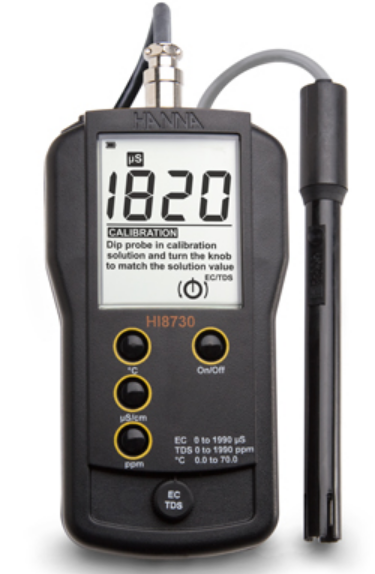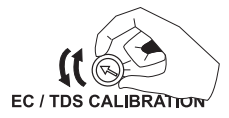Hanna Instruments EC, TDS, Temperature Meter HI 8730 | Instruction Manual

Content

Introduction of Hanna Instruments EC, TDS, and Temperature Meter HI 8730
Hanna EC, TDS, and Temperature Meter HI is a versatile and accurate measuring instrument designed for various applications such as water treatment, food processing, and environmental monitoring. The HI 8730 measures Electrical Conductivity (EC), Total Dissolved Solids (TDS), and Temperature with a high degree of precision. It has an estimated price range of $200 to $300 and was launched in 2021.
Detailed Specifications
The HI 8730 has several key features that make it an excellent choice for professionals and hobbyists alike. These features include:
- Measures Electrical Conductivity (EC) from 0.0 to 1999.9 mS/cm with an accuracy of ±1% of reading ±2 digits
- Measures Total Dissolved Solids (TDS) from 0 to 9999 ppm with an accuracy of ±3% of reading ±3 digits
- Measures Temperature from 0 to 50°C with an accuracy of ±0.2°C
- Automatic Temperature Compensation (ATC)
- Backlit LCD for easy reading in low light conditions
- Auto-ranging for quick and accurate measurements
- Auto Off feature to conserve battery life
- Hold function to retain readings on the display
- Pocket-sized design for portability
| Specification | Detail |
|---|---|
| Range | EC: 0 to 1990 µS/cm |
| TDS: 0 to 1990 ppm | |
| Temperature: 0 to 70°C (*) | |
| Resolution | EC: 10 µS/cm |
| TDS: 10 ppm | |
| Temperature: 1°C | |
| Accuracy | EC/TDS: ±2% f.s. |
| Temperature: ±1°C | |
| TDS Factor | 0.5 |
| Calibration | EC/TDS: Manual, 1 point, through front knob |
| Temperature: Factory calibrated | |
| Probe | HI 761285 (included) |
| Temperature Compensation | Automatic, 0 to 50°C (32 to 122°F) with β=2%/°C |
| Environment | 0 to 50°C (32 to 122°F); RH max 100% |
| Battery Type / Life | 1x9V alkaline / approx. 250 hours |
| Dimensions | 164 x 76 x 45 mm (6.4 x 3.0 x 1.8”) |
| Weight | 250 g (8.8 oz.) |
If using HI 761285 probe, it is recommended not to exceed 50°C
FUNCTIONAL DESCRIPTION

- DIN connector for probe
- Liquid Crystal Display
- μS/cm (EC) range selection key
- EC/TDS calibration knob
- ppm (TDS) selection key
- °C (Temperature) selection key
- ON/OFF key
ACCESSORIES
- HI 761285 Conductivity probe with built-in temperature sensor, DIN connector and 1 m (3.3’) cable
- HI 70031P 1413 μS/cm solution, 20 mL sachet (25 pcs)
- HI 7031M 1413 μS/cm solution, 230 mL bottle
- HI 7031L 1413 μS/cm solution, 500 mL bottle
- HI 70032P 1382 ppm solution, 20 mL sachet (25 pcs)
- HI 7032M 1382 ppm solution, 230 mL bottle
- HI 7032L 1382 ppm solution, 500 mL bottle
- HI 700661P Cleaning solution, general purpose, 20 mL sachet (25 pcs)
- HI 7061M Cleaning solution, general purpose, 230 mL
- HI 7061L Cleaning solution, general purpose, 500 mL
- HI 7073M Protein cleaning solution, 230 mL bottle
- HI 7073L Protein cleaning solution, 500 mL bottle
- HI 7074M Inorganic cleaning solution, 230 mL bottle
- HI 7074L Inorganic cleaning solution, 500 mL bottle
- HI 7077M Oil & Fat cleaning solution, 230 mL bottle
- HI 7077L Oil & Fat cleaning solution, 500 mL bottle
Setup Guide
Setting up the HI 8730 is a straightforward process
- Turn on the meter by pressing the power button.
- Calibrate the meter using the appropriate calibration solution. This can be done by pressing the "CAL" button and following the on-screen prompts.
- Insert the electrode into the solution you want to measure. Ensure the electrode is fully submerged for accurate readings.
- Wait for the meter to stabilize and display the reading. 5. Press the "HOLD" button to retain the reading on the display.
PRELIMINARY EXAMINATION
Remove the instrument from the packing material and examine it carefully. If any damage has occurred during shipment, immediately notify your Dealer or the nearest Hanna Customer Service Center.
The meter is supplied with
- HI 761285 conductivity probe with built-in temperature sensor, DIN connector and 1 m (3.3’) cable
- HI 70031 (1413 μS/cm) calibration solution sachet
- HI 70032 (1382 ppm) calibration solution sachet
- Battery & instructions
Note: Conserve all packing material until the instrument has been observed to function correctly. Any defective item must be returned in its original packing.
GENERAL DESCRIPTION
HI 8730 is a complete, versatile and water-tight conductivity meter, that can measure EC in the 0 to 1990 μS/cm range, TDS from 0 to 1990 ppm, and temperature from 0 to 70°C. The desired measurement mode is easily selectable through a membrane keyboard on the front panel. Conductivity measurements are automatically compensated for temperature changes with a fixed coefficient of 2%/°C. The HI 761285 probe features a built-in temperature sensor, and it has been designed to require little maintenance. The meter can be calibrated at one point for EC or TDS, while the temperature range is factory-calibrated.
TAKING MEASUREMENTS
- The meter is supplied complete with a 9V battery. Remove the battery compartment cover on the back of the meter and install the battery while paying attention to its polarity.
- Connect the probe to the DIN socket on the top of the meter by aligning the pins with the socket and pushing in the plug.
- Turn the meter on by pressing the ON/OFF key.
- Immerse the tip of the probe into the sample to be tested. If possible, use plastic beakers to minimize any EMC interference.
- Tap the probe lightly on the bottom of the beaker to remove any air bubbles which may be trapped inside.
- Select the desired measurement range, by pressing the corresponding key: “μS/cm” for EC or “ppm” for TDS.
Wait a couple of minutes for the temperature sensor to reach thermal equilibrium. The display will then show the measurement automatically temperature compensated for temperature with the appropriate indication: “μS” symbol indicates the meter is in EC mode, while no symbol means that the meter is in TDS mode.

- • To read the temperature of the solution, select the temperature
mode, by pressing the “°C” key. Wait a couple of minutes for the reading to adjust and stabilize. The display will show the temperature value.

Note
If the display shows only a “1” on the left-hand side, the reading is out of range.

- It is recommended to clean often the probe (see “Probe Maintenance” section for details).
- After measurements, switch the meter off, clean the probe and store it with the protective cap.
CALIBRATION
- Turn the meter on.
- Pour a small quantity of HI 70031 (1413 μS/cm) EC calibration solution or HI 70032 (1382 ppm) TDS calibration solution into a clean beaker. If possible, use plastic beakers to minimize any EMC interference.
Note: The conversion factor between EC and TDS readings is made by a built-in circuit. Therefore, it is requested to calibrate only one range (EC or TDS), and the otherrange will be automatically calibrated. - Immerse the probe in the calibration solution and wait for a couple of minutes for thermal equilibrium to be reached.
- Tap the probe on the bottom, then shake it, to make sure no air bubbles remain trapped inside the probe.
- Press the "μS/cm" (or "ppm") key.
- Turn the EC/TDS calibration knob until the display shows the calibration solution value.

Note: For best accuracy, the probe body should not touch nor stand close to the side walls of the beaker.
BATTERY REPLACEMENT
This meter is powered by a 9V alkaline battery. A low battery condition is indicated by a blinking additional decimal point.

When the low battery indication appears, only a few hours of working time are left. When the battery level is too low to ensure reliable measurements, the meter turns off. It is recommended to replace the battery immediately. Battery replacement must only take place in a nonhazardous area using a 9V alkaline battery. Unscrew the three screws on the rear of the meter, remove the battery compartment cover and replace the 9V battery with a new one, while paying attention to the correct polarity. Make sure the battery contacts are tight and secure before replacing the cover.

MAINTENANCE
Periodic Maintenance
- Inspect the probe and the cable. The cable used for the connection to the meter must be intact and there must be no points of broken insulation on the cable or cracks on the probe stem or bulb.
- The connector must be perfectly clean and dry. If any scratches or cracks are present, replace the electrode. Rinse off any salt deposits with water.
Cleaning Procedure
For better accuracy in measurements and to ensure a good performance of the probe, a frequent cleaning is recommended.
- Immerse the tip of the probe in the HI 7061 cleaning solution for half an hour.
Note: For particular dirty (as for example protein, oil or grease), see the “Accessories” section for Hanna-specific solutions. - If a more thorough cleaning is required, brush the metal pins with very fine sandpaper.
- After cleaning, rinse the probe with tap water and recalibrate the instrument. If it is not possible to calibrate, the probe has to be replaced with a new one.
Note: For field applications, it is always recommended to keep a spare probe handy. When anomalies are not resolved with simple maintenance, change the probe and recalibrate the meter.
EC/TDS CONVERSION FACTOR
The TDS value in aqueous solutions is directly proportional to the conductivity. The ratio between the two parameters depends on the solution. HI 8730 is provided with a fixed conversion factor, set to 0.5.This means that 1 μS/cm is equal to 0.5 ppm of TDS.
Troubleshooting
Common problems with the HI 8730 and their solutions include
- Inaccurate readings: Ensure the electrode is clean and free from any buildup. If the problem persists, calibrate the meter using the appropriate calibration solution.
- No reading: Check the battery level and replace the batteries if necessary. Ensure the electrode is properly inserted and the meter is turned on.
- Drifting readings: This could be due to a buildup on the electrode or a change in temperature. Clean the electrode and ensure the meter is in a stable temperature environment.
Pros & Cons of EC, TDS, and Temperature Meter
Pros
- Accurate and reliable measurements
- Easy to use and set up
- Portable and lightweight design
- Automatic Temperature Compensation (ATC)
- Backlit LCD for easy reading in low light conditions
Cons
- May require regular calibration
- Battery life may not be sufficient for extended use
Faqs
How can the Hanna HI 8730 be calibrated to take precise measurements?
Is it possible to test TDS and EC simultaneously with the Hanna HI 8730?
Which temperature range is covered by the Hanna HI 8730?
How should the HI 8730's probes be cleaned and maintained?
If the readings from the Hanna HI 8730 are inconsistent, what should I do?
How waterproof is the Hanna HI 8730 Metre?
How can I troubleshoot the Hanna HI 8730 when I see an error message?
When not in use, how should I store the Hanna HI 8730?
Can I change the Hanna HI 8730 Meter's batteries on my own?
Which warranty does the Hanna HI 8730 Metre come with?
Leave a Comment
